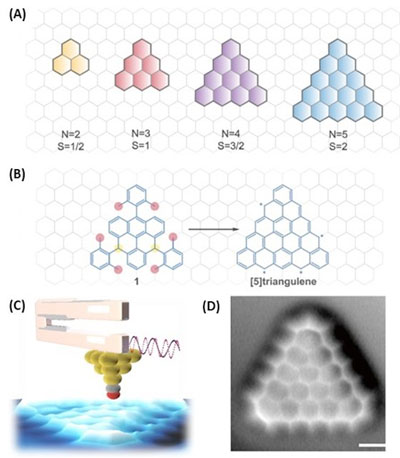| Sep 09, 2019 | |
Synthesis of molecule with high magnetic spin(Nanowerk News) National University of Singapore (NUS) chemists have synthesised and characterised π-extended triangulene molecules with ferromagnetically coupled edge states for molecular spintronic devices (Science Advances, "Atomically precise bottom-up synthesis of pi-extended [5]triangulene"). |
|
|
When triangular motifs are clipped along the zigzag orientation of graphene, a family of zigzag-edged triangular graphene molecules (ZTGMs) can be created. These molecules, also known as non-Kekulé polynuclear benzonoid compounds, are predicted to have multiple unpaired |
|
| An example is the high-spin π-extended [5]triangulene molecule (N=5, where N represents the number of carbon atoms at the zigzag edges (Figure (A)). Due to their ferromagnetic properties, these molecules are considered potential candidates for the development of next generation molecular spintronic devices. | |
| However, the direct chemical synthesis of ZTGMs using a wet-chemistry approach has been a challenge due to their high chemical instability. | |
 |
|
| Figure (A) shows open-shell zigzag-edged triangular graphene molecules (ZTGMs) with a different number of zigzag carbon atoms (N) and predicted spin multiplicity (S). The molecules are in yellow: Monoradical phenalenyl (N=2), red: Biradical triangulene (N=3), violet: |
|
| A research team led by Prof LU Jiong and Prof WU Jishan, both from the Department of Chemistry, NUS has developed a bottom-up synthetic approach to synthesise π-extended [5]triangulene molecules on copper and gold substrates under ultra-high vacuum condition. The π-extended [5]triangulene molecule consists of 15 benzene rings fused in a triangular fashion (Figure (B)). | |
| To achieve on-surface synthesis of this high-spin molecule, the researchers designed a unique molecular precursor that contained a central triangular core with six hexagonal benzene rings and three 2,6-dimethylphenyl substituents attached at the meso-positions of the core. | |
| At elevated temperatures on a catalytic metallic surface, the precursor molecule undergoes cyclodehydrogenation and ring closure reactions to produce the π-extended [5]triangulene molecules. | |
| Using non-contact atomic force microscopy (nc-AFM) with a carbon monoxide (CO)-functionalised tip (Figure (C)), the team was able to map out the molecular skeleton of the [5]triangulene molecule at a temperature of 4.5 Kelvin, showing 15 fused benzene rings arranged in a triangular manner with zigzag topology at the edges (Figure (D)). | |
| Scanning tunnelling spectroscopy measurements showed that the [5]triangulene molecule had edge-localised electronic states, which follow theoretical predictions. | |
| Prof Lu said, "These findings enable the electronic and magnetic properties of the π-extended [5]triangulenes to be explored at the single molecule level. They also open up a new methodology for the fabrication of larger triangular zigzag-edged graphene quantum dots for spin and quantum transport applications." | |
| The research team plans to continue developing similar materials systems with different molecular sizes and high-spin states to understand their electronic and magnetic properties on a variety of substrates for future spintronic devices. |
| Source: National University of Singapore | |
|
Subscribe to a free copy of one of our daily Nanowerk Newsletter Email Digests with a compilation of all of the day's news. |
